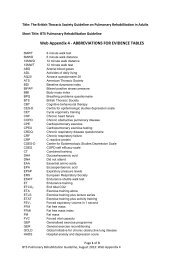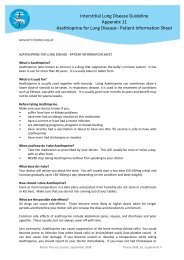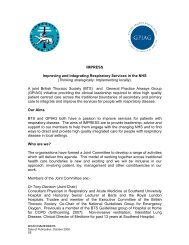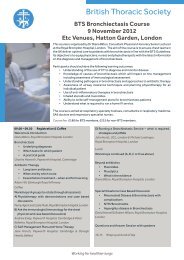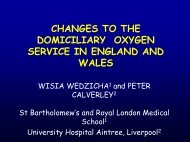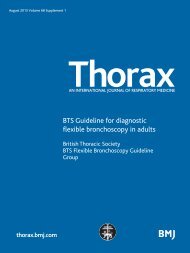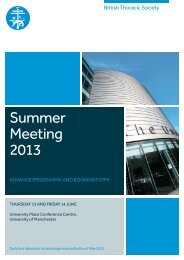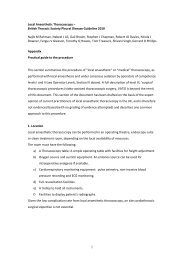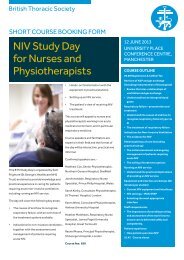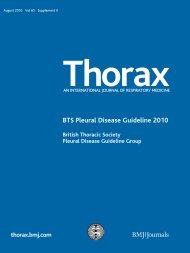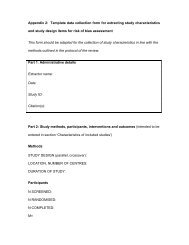Guidelines for the management of community ... - Brit Thoracic
Guidelines for the management of community ... - Brit Thoracic
Guidelines for the management of community ... - Brit Thoracic
You also want an ePaper? Increase the reach of your titles
YUMPU automatically turns print PDFs into web optimized ePapers that Google loves.
BTS guidelines<br />
patients treated <strong>for</strong> CAP did not have radiographic abnormalities.<br />
471 [III]<br />
In patients with CAP, broad-spectrum intravenous antibiotics<br />
should only be used following careful consideration, taking into<br />
account severity <strong>of</strong> illness, likely pathogens involved and<br />
patient-specific factors such as <strong>the</strong> ability to tolerate oral<br />
medication. Whenever appropriate, narrow-spectrum oral antibiotics<br />
should be used preferentially.<br />
Recommendations<br />
c The diagnosis <strong>of</strong> CAP and <strong>the</strong> decision to start<br />
antibiotics should be reviewed by a senior clinician<br />
at <strong>the</strong> earliest opportunity. There should be no barrier<br />
to discontinuing antibiotics if <strong>the</strong>y are not indicated.<br />
[D]<br />
c The indication <strong>for</strong> antibiotics should be clearly documented<br />
in <strong>the</strong> medical notes. [D]<br />
c The need <strong>for</strong> intravenous antibiotics should be<br />
reviewed daily. [D]<br />
c De-escalation <strong>of</strong> <strong>the</strong>rapy, including <strong>the</strong> switch from<br />
intravenous to oral antibiotics, should be considered as<br />
soon as is appropriate, taking into account response to<br />
treatment and changing illness severity. [D]<br />
c Strong consideration should be given to narrowing <strong>the</strong><br />
spectrum <strong>of</strong> antibiotic <strong>the</strong>rapy when specific pathogens<br />
are identified or when <strong>the</strong> patient’s condition<br />
improves. [D]<br />
c Where appropriate, stop dates should be specified <strong>for</strong><br />
antibiotic prescriptions. [D]<br />
(B) SPECIFIC PATHOGEN-DIRECTED ANTIBIOTIC<br />
THERAPY<br />
8.19 What are <strong>the</strong> optimum antibiotic choices when specific<br />
pathogens have been identified?<br />
In routine clinical practice, only about one-third to one-quarter<br />
<strong>of</strong> patients with CAP admitted to hospital will be defined<br />
microbiologically. Of <strong>the</strong>se, some such as mycoplasma, chlamydophila<br />
and C burnetii infection will be diagnosed late in <strong>the</strong><br />
illness on <strong>the</strong> basis <strong>of</strong> seroconversion, reducing <strong>the</strong> opportunity<br />
<strong>for</strong> early targeted <strong>the</strong>rapy. Among patients managed in <strong>the</strong><br />
<strong>community</strong>, very few will be microbiologically defined.<br />
When a pathogen has been identified, specific <strong>the</strong>rapy as<br />
summarised in table 6 is proposed. In transferring patients from<br />
empirical to pathogen-targeted <strong>the</strong>rapy, <strong>the</strong> regimen and route<br />
<strong>of</strong> administration will be determined by <strong>the</strong> continued need <strong>for</strong><br />
parenteral <strong>the</strong>rapy and known drug intolerance. Hence, table 6<br />
provides preferred and alternative regimens <strong>for</strong> intravenous or<br />
oral administration. However, it should be remembered that<br />
approximately 10% (see Section 3) <strong>of</strong> infections will be <strong>of</strong> mixed<br />
aetiology, although many such co-pathogens will be viral and<br />
hence not influenced by antibiotic choice. These recommendations<br />
are again based on a syn<strong>the</strong>sis <strong>of</strong> in<strong>for</strong>mation which<br />
includes in vitro activity <strong>of</strong> <strong>the</strong> drugs, appropriate pharmacokinetics<br />
and clinical evidence <strong>of</strong> efficacy gleaned from a variety<br />
<strong>of</strong> studies. The choice <strong>of</strong> agent may be modified following <strong>the</strong><br />
availability <strong>of</strong> sensitivity testing or following consultation with<br />
a specialist in microbiology, infectious disease or respiratory<br />
medicine.<br />
Currently, S pneumoniae highly resistant to penicillin (MIC<br />
>4 mg/l) is uncommon in <strong>the</strong> UK. S aureus is an uncommon<br />
cause <strong>of</strong> CAP in <strong>the</strong> UK. Most <strong>community</strong> isolates are<br />
Thorax 2009;64(Suppl III):iii1–iii55. doi:10.1136/thx.2009.121434<br />
methicillin-sensitive, although <strong>the</strong> recent increase in MRSA in<br />
hospitalised patients may result in subsequent readmission with<br />
an MRSA infection which may include CAP. Options <strong>for</strong><br />
methicillin-sensitive and methicillin-resistant infections are<br />
based on parenteral administration in view <strong>of</strong> <strong>the</strong> serious<br />
nature <strong>of</strong> staphylococcal pneumonia.<br />
Recommendations<br />
c If a specific pathogen has been identified, <strong>the</strong> antibiotic<br />
recommendations are summarised in table 6 [C].<br />
8.20 Specific issues regarding <strong>the</strong> <strong>management</strong> <strong>of</strong> Legionnaires’<br />
disease<br />
Legionella infection is unique as a cause <strong>of</strong> CAP owing to <strong>the</strong><br />
mode <strong>of</strong> spread and <strong>the</strong> importance <strong>of</strong> trying to identify <strong>the</strong><br />
source to prevent fur<strong>the</strong>r cases. The infection is acquired by<br />
inhaling water mist containing legionella bacteria, which are<br />
commonly found in natural and manmade water systems.<br />
Common sources include drift from evaporative cooling towers<br />
and aerosols generated from showers, aerated hot tubs,<br />
humidifiers and potable water. In addition, <strong>the</strong> propensity to<br />
cause severe illness including multiple organ failure and <strong>the</strong> lack<br />
<strong>of</strong> response to b-lactam antibiotics suggests that specific<br />
guidance will be helpful to clinicians managing a case.<br />
Detection <strong>of</strong> legionella urinary antigen using a rapid<br />
technique has revolutionised <strong>the</strong> early diagnosis <strong>of</strong> pneumonia<br />
caused by L pneumophila serogroup 1 which is responsible <strong>for</strong><br />
over 90% <strong>of</strong> <strong>community</strong> cases in <strong>the</strong> UK and Europe. This is a<br />
highly sensitive and specific test, particularly in patients who<br />
are unwell enough or who have been ill long enough to require<br />
hospital admission (see Section 6). Although urinary antigen<br />
detection is now <strong>the</strong> most valuable and frequently used<br />
diagnostic test, sputum culture still has a vital role in diagnosing<br />
infection caused by o<strong>the</strong>r legionella serogroups and species. It is<br />
also invaluable <strong>for</strong> matching legionella species and strains<br />
identified from cases, with those positive water cultures from<br />
a potential source. This can help prevent fur<strong>the</strong>r cases <strong>of</strong><br />
infection. It is <strong>the</strong>re<strong>for</strong>e important to send <strong>of</strong>f sputum or<br />
respiratory secretions specifically <strong>for</strong> legionella culture, even in<br />
proven cases and after appropriate antibiotics have started (see<br />
Section 5.11.5).<br />
Legionnaires’ disease is not currently a notifiable disease in<br />
<strong>the</strong> UK, but urgent action to investigate <strong>the</strong> source <strong>of</strong> infection<br />
is essential. In proven cases <strong>of</strong> legionella pneumonia, <strong>the</strong><br />
clinician should liaise with <strong>the</strong> clinical microbiologist to confirm<br />
that <strong>the</strong> local Health Protection Unit has been in<strong>for</strong>med. The<br />
Health Protection Unit should initiate immediate investigations<br />
and this will include recording details <strong>of</strong> recent travel and<br />
activities within <strong>the</strong> 2 weeks be<strong>for</strong>e illness onset (<strong>the</strong> usual<br />
incubation period is 2–10 days) from <strong>the</strong> patient or <strong>the</strong>ir<br />
relatives to assist epidemiological investigation. Clinicians<br />
should help by explaining <strong>the</strong> need <strong>for</strong> this to patients and<br />
relatives; this is important, especially at a time when <strong>the</strong> patient<br />
may be very unwell and <strong>the</strong>ir relatives distressed. The Health<br />
Protection Agency (HPA) will also request a clinical in<strong>for</strong>mation<br />
sheet to be completed which provides very valuable (anonymous)<br />
clinical and outcome data to update <strong>the</strong> ongoing<br />
national and European data sets which are available from <strong>the</strong><br />
HPA website (www.hpa.org.uk) or, <strong>for</strong> Scotland, from Health<br />
Protection Scotland (www.hps.scot.nhs.uk) and <strong>the</strong> European<br />
Working Group <strong>for</strong> Legionella Infections (www.ewgli.org).<br />
Fur<strong>the</strong>r details about <strong>the</strong> investigation <strong>of</strong> a potential source <strong>of</strong><br />
iii41



